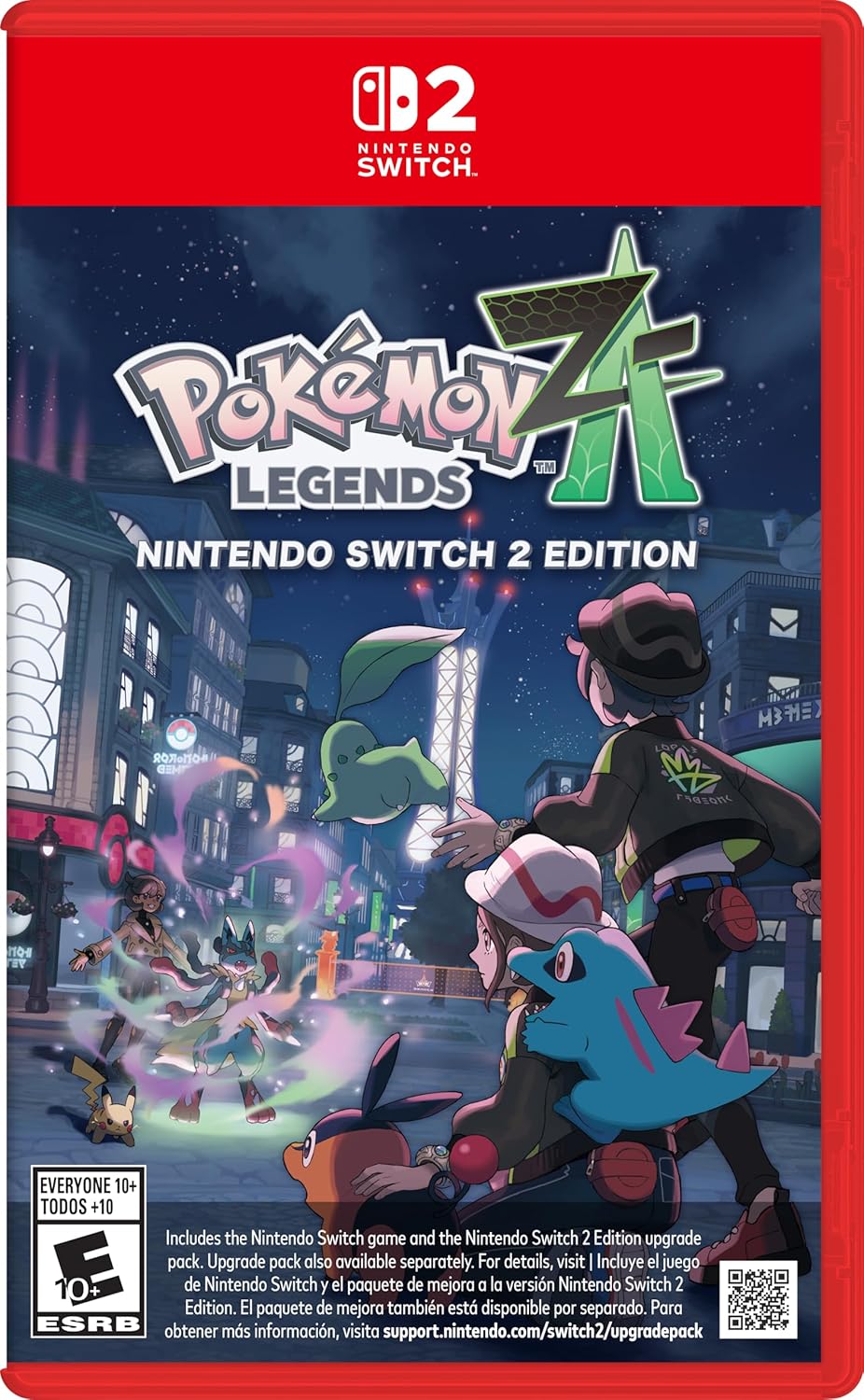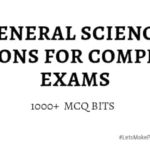General Science NCERT MCQ Bits
General Science Questions and Answers For Competitive exams
Test Paper 13
Learn General Science questions and answers NCERT MCQ for exams
1) The amount of energy produced on complete combustion of 1 kg of a fuel is known as?
Pokémon Legends: Z-A – Nintendo Switch 2
a) Calorific Value
b) Combustion Value
c) Ignition Value
d) None of the above
a) Calorific Value
2) The calorific value is expressed in the units of?
a) calories per kg
b) joules per kg
c) Kilo-joules per kg
d) None
c) Kilo-joules per kg
3) The calorific value of a Coal is?
a) 6000-8000 KJ/KG
b) 25000-33000 KJ/KG
c) 150000 KJ/KG
d) 45000 KJ/KG
b) 25000-33000 KJ/KG
4) Increased concentration of the carbon dioxide in the air will result in?
a) Deforestation
b) Global Warming
c) Both a and b
d) None of the above
b) Global Warming
5) Droughts are caused by?
a) Increase in temperature on the earth
b) Disturbance of water cycle
c) Reduction of rainfall
d) All of the above
d) All of the above
6) Deforestation leads to?
a) Rainfall
b) Change in soil properties
c) Both a and b
d) None of the mentioned
b) Change in soil properties
7) The conversion of fertile lands into deserts is called as?
a) Desertification
b) Landslides
c) Fertilization
d) None
a) Desertification
8) Removal of top most layer of soil is called as?
a) Soil Destruction
b) Soil Erosion
c) Both a and b
d) None of the above
b) Soil Erosion
9) Decrease in water holding capacity of soil is caused by?
a) Soil Erosion
b) Desertification
c) Soil Destruction
d) Deforestation
d) Deforestation
10) The areas reserved for Conservation of biodiversity are called as?
a) Protected Lands
b) Biosphere Reserve
c) National Parks
d) None of the above
b) Biosphere Reserve
11) Flora and Fauna are referred as _______?
a) Plants and animals found in a particular area
b) Plants and animals found at different areas
c) Forest Plants
d) None
a) Plants and animals found in a particular area
12) Species of plants and animals found exclusively in a particular area.
a) Endemic Species
b) Flora
c) Fauna
d) None
a) Endemic Species
13) Leaves Prepares food during ___________ process using water and carbon dioxide.
a) Photosynthesis
b) Back Photosynthesis
c) Photosynthesis Cloning
d) Both a and b
a) Photosynthesis
14) The Plants observes minerals and water from which part of the plant?
a) Stem
b) Root
c) Both
d) None of the above
b) Root
15) An ecosystem is made up of?
a) Plants
b) Animals
c) Micro organisms
d) All of the above
d) All of the above
16) A book which keeps record of all endangered animals is called as?
a) Black Data Book
b) Red Data Book
c) Both a and b
d) None of the above
b) Red Data Book
17) The basic structural unit of an organ is called as?
a) Piece
b) Cell
c) Vessel
d) None
b) Cell
18) Robert Hooke observed ____ among the following?
a) Cork Cells
b) Slices
c) Both a and b
d) None of the above
a) Cork Cells
19) Organisms made up of more than one cell are called as?
a) Multi cellular organisms
b) Bi cellular organisms
c) Unicellular organisms
d) None
a) Multi cellular organisms
20) Organisms made up of single cell are called as?
a) Unicellular organisms
b) Bi cellular organisms
c) Both a and b
d) None
a) Unicellular organisms
21) Amoeba is an example of _______ organism?
a) Unicellular
b) Bi cellular
c) Multi cellular
d) None
a) Unicellular
22) The shape of Amoeba?
a) Star
b) Oval
c) Square
d) Shapeless
d) Shapeless
23) The change of shape of Amoeba is due to?
a) Unicellular model
b) Formation of Single Cell
c) Formation of Pseudopodia
d) None
c) Formation of Pseudopodia
24) ______ among the following is unicellular?
a) Amoeba
b) White Blood Cell
c) Both a and b
d) None
c) Both a and b
25) The least smallest cell exists in the following?
a) Algae
b) Fungi
c) Bacteria
d) Amoeba
c) Bacteria
26) The largest cell exists in the following?
a) Human Being
b) Lion
c) Egg of the Ostrich
d) All of the above
c) Egg of the Ostrich
27) Each organ is made up of a smaller parts called ____?
a) Cells
b) Tissues
c) Slices
d) None
b) Tissues
28) The outer thick layer in cells of plants is called as?
a) Cell Membrane
b) Nucleus
c) Cell Wall
d) None
c) Cell Wall
29) The jelly like substance present between the cell membrane and the nucleus is called as?
a) Cytoplasm
b) Cell Wall
c) Both a and b
d) None of the above
a) Cytoplasm
30) Nucleus is separated from the cytoplasm by a membrane called?
a) Nuclear Membrane
b) Cell Wall
c) Nucleus
d) None
a) Nuclear Membrane
31) Nucleus contains thread like structures called as?
a) Cells
b) Tissues
c) Genes
d) Chromosomes
d) Chromosomes
32) Chromosomes helps in carrying ____?
a) Cells
b) Tissues
c) Genes
d) Both a and b
c) Genes
33) The cells having nuclear material without nuclear membrane are termed as ?
a) Eukaryotes
b) Prokaryotic cells
c) Both a and b
d) None of the above mentioned
b) Prokaryotic cells
34) The organisms other than bacteria and blue green algae are called?
a) Eukaryotes
b) Prokaryotes
c) Both a and b
d) None
a) Eukaryotes
35) Examples of Prokaryotes from the following?
a) Bacteria
b) Blue green Algae
c) Both a and b
d) None
c) Both a and b
36) Transportation of water and nutrients in plant through Vascular tissue is called ?
a) Pholem
b) Xylem
c) Both
d) Cell Membrane
b) Xylem
37) Cell wall is absent in?
a) Plant cell
b) Animal Cell
c) Both a and b
d) None
b) Animal Cell
38) The stage of the embryo in which all the body parts can be identified is called as?
a) Fertilization
b) Foetus
c) Both a and b
d) None
b) Foetus
39) The animals which give birth to young ones are called as?
a) Viviparous
b) Oviparous
c) Omnivorous
d) None of the above
a) Viviparous
40) The animals which lay eggs to give birth are called as?
a) Viviparous
b) Oviparous
c) Both a and b
d) None of the mentioned
b) Oviparous
41) The transformation of the larva into an adult through drastic changes is called as?
a) Metamorphosis
b) Fertilization
c) Reproduction
d) None of the above
a) Metamorphosis
42) The reproduction in which an animal reproduces by dividing into two individuals is called as?
a) Binary Fusion
b) Binary Fission
c) Binary Reproduction
d) None
b) Binary Fission
43) The reproductive parts in flower ?
a) Male – Stamens and Female- Pistil
b) Male – Pistil and Female- Stamens
c) Male – Stamens and Female- Hypha
d) Male – Hypha and Female- Stamens
a) Male – Stamens and Female- Pistil
44) Bisexual flowers?
a) Rose
b) Petunia
c) Mustard
d) All the above
d) All the above
45) At puberty Stage, _____ begins to grow?
a) Larynx
b) Voice box
c) Both a and b
d) None
c) Both a and b
46) Uni sexual flowers ?
a) Papaya
b) Corn
c) Cucumber
d) All of the above
d) All the above
47) Hormones are secreted by _____ Glands.
a) Endocrine Glands
b) Reproductive System
c) Pituitary Gland
d) None
a) Endocrine Glands
48) Pituitary gland also produces ____?
a) Growth hormone
b) Adrenalin
c) Insulin
d) All of the above
a) Growth hormone
49) Transportation of food in plant through vascular tissue is called as?
a) Xylem
b) Phloem
c) Transportation
d) None
b) Phloem
50) Thyroxin is produced by?
a) Thyroid
b) Adrenalin
c) Both a and b
d) None
a) Thyroid
Learn More
Link 1 – Physics | Biology | Indian History | T-History MCQ Questions Test papers
Link 2 – Buy/Downlaod Physics MCQ Bit Bank eBook
Link 3 – Free eBooks For Competitive Exams
Link 4 – Top Books for Competitive Exams
Link 5 – Download Quantitative and Aptitude Competitive Exams
For Complete GK/GS – Click Here
#LetsMakePreparingForGovtJobsEasy
Related Search
science quiz for class 7, general objectives of science, simple gk questions, science quiz for grade 6, easy gk questions, ncert study material, ncert books for class 6, ncert books for class 8 mcq bits, ncert books for class 8 question and answers, ncert books for class 8 for exams bits, ncert science book class 8 MCQ test online, ncert science online test, ncert bits, ncert mcq, ncert based mcq for aipmt, ncert based mcq books, ncert based mcq, ncert biology objective question, ncert online exam preparation, ncert mcq for exams, ncert mcqfor upsc, ncert mcq questions for competitive exams, ncert mcq tspsc exams, General science GK ncert mcq questions, science ncert mcq bits for exams


